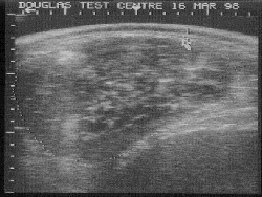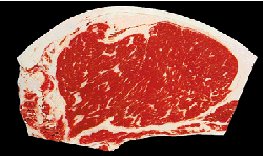
Saturday, March 26, 2011
My first week...

Tuesday, March 22, 2011
Hello from Nebraska!
 |
| Here is an ultrasonic picture that would be used to determine rib eye area and fat depth. |
 |
| Here is what a rib eye steak, like you see in the super market, looks like. Can you see the similarities between it and the picture above? |
Saturday, March 19, 2011
A modern day cattle drive…
Yesterday we moved all the cows and calves home from the stalk field. We move them home about this time every year so we can vaccinate the calves to protect them from disease and illness and breed the cows. The stalk field is only about 3 miles from the house so instead of hauling them by trailer, we have a good ole modern day cattle drive. Since we feed the cows using the cake truck every day, they will follow it because they have associated it with feed! This is how we lead them home; they follow the cake truck. We use a 4 wheeler and ranger to keep the cattle moving and to be sure they don’t wander off the road!
There are several people involved to make sure that everything goes right and there aren’t any major disasters! Moving cattle is a family affair for us. It takes mom, dad, and I to get the job done. Mom drives the cake truck and dad and I push the cattle. We always call the police department an hour or so before we move them because there is a highway that we have to cross. When we get close to the crossing, the policeman turn on their flashing lights to block the traffic. It is important to make sure that the drivers on the road and the cattle stay safe!
Here are a few pictures…I wish I could have taken more but I was trying to push the slower cattle to keep them moving.
Feel free to comment and ask any questions if you have any!
Wednesday, March 16, 2011
Mr. and Mrs. Joey Pepmiller
Well we finally made it home safe and sound from Pensacola. I had my doubts a few times while trying to get through the Atlanta airport, but we made it!
The wedding was GORGEOUS! I might be slightly bias but I think you will agree when looking at the pictures. It was a very small, intimate wedding that took place on the beach. There were even a few dolphins that swam by playing in the water in the middle of it! I don’t have very many pictures of the actual ceremony since I was in the wedding but I do have pictures of the bridesmaids getting ready and the reception.
I am so glad that I was able to go spend the week in FL and have the opportunity to help my sister get ready for her special day! We made many memories, had lots of laughs, and only a few tears fell! (I tried my best to hold them in until after the ceremony!)

Some of Lexi’s friends from OKC that were able to make the drive! These girls were a lot of fun…


Joey surprised Lexi with a CD (it had a song that was significant to them on it) and a sweet note the morning of the wedding.
The groom and groomsman getting all the chairs set up the morning of the wedding.
The view off the girls’ balcony the morning of the wedding! It was a beautiful day!





Friday, March 11, 2011
Day 2 of Wedding Prep and fun on the Beach…
Hello everyone! It’s been a really nice day here at Navarre and there was virtually no wind until later this afternoon. No wind or even a light breeze is a real blessing compared to the Kansas weather I am used to!
This morning Lex (the bride) and I got up and drove to Sam’s bright and early to purchase flowers for arrangements. We purchased a variety of beautiful flowers and I am excited to arrange them!
We all took a break from prep work and set aside some time to lay out on the beach this afternoon. We had a great time and enjoyed the sunny weather! Baron, Lex’s brother, arrived this afternoon and is an avid fisherman. He spent the afternoon fly fishing on the beach and I was able to get some great pics! (I am pretty biased but I think they turned out cool…)
Thursday, March 10, 2011
On the beach!!!
Good morning friends! I am at Navarre Beach this week for my cousins wedding on Sunday! It is BEAUTIFUL here…the house is on a private beach so it is very nice and peaceful! I went out this morning to take some pictures. I am ready for all the cousins to get here so I can take pictures of them on the beach…as most of you know, I LOVE taking pictures and hope to turn my hobby into a small business in the future (hopefully sooner than later)! Enjoy the pics and I will post more later!
The amazing beach house where the wedding reception will take place!
My shoes…I love them. Sanuk’s are the best.
Sunday, March 6, 2011
Calf care is their top priority…
This past week I had the opportunity to take a tour of the Empire Calf Ranch. I was totally amazed at not only the size of this facility but also the amount of organization and order that was required to keep it running efficiently. The people at this facility take a lot of pride in what they do and are sure to give the calves the absolute best care they can!
The calf ranch has the capacity to hold 24,000 calves when it is full. These calves range anywhere from a couple of days old to 400 pounds. In the dairy business, since milk is the main enterprise heifer calves are much more valuable than bull calves (the males). The elite bull calves are kept as bulls (uncastrated) and used for reproduction. However, this is only a small number. The remainder of the bulls go to operations like the Empire Calf Ranch. They either receive calves shortly after birth or at 200 pounds. The baby calves are delivered on semis but carried off the trailer by hand to ensure they are kept safe and free from injury. The babies are fed a bottle containing milk twice a day as well as feed and always have a supply of water. When I visited, there were 2,000 babies on bottles! They have a milk room where all the milk is stored, pasteurized, and put into bottles.
They fill the bottles with milk using a wand that can fill several bottles at once! After they are used the bottles and nipples go through a dish waster to make sure they are cleaned and free from germs for the next feeding.
After the bottles are filled, one person goes through and puts all the nipples on. After that, the trailers of bottles are taken out to the baby calves and put in their bottle holders. Once the calves have finished their bottles, the bottles are picked up and taken back to the milk room to be cleaned out for the next feeding.
The calf ranch designed special jackets to put on the baby calves during extreme weather conditions so they can stay warm.
The calves are kept in individual houses for the first few months and then they are transferred into large pens when they are fed on a grain and roughage diet. I was amazed at how well the pens were kept up. They were virtually free from mud and a bed of straw is kept under the shades for the calves to lay on. The shades are the tall overhangs you see. During the hot months they provide the calves a way to escape the direct sunlight and heat to keep them cool. You can see the long path in the middle of the picture. The calves are fed on the right and left sides of it. The path was so clean, I could have eaten off it…I am not kidding!
With this many calves, you may be wondering how they keep track of all of them. Detailed records are kept on every calf. They know when medication is given if the calf is sick or running a fever, what day it arrives on the ranch, what dairy the calf originated from, etc. The ranch employs 55 people and one employees job is to keep track of all the records and make sure they are entered into the computer system properly. Other jobs include milk preparation, calf health, pen maintenance, feeding, calf delivery… As you can see, it takes many integral parts to make the ranch runs smoothly, efficiently, and calf care is the top priority. I was totally impressed by the Empire Calf Ranch, they do a great job!
Friday, March 4, 2011
My first video for the blog!!!
Hello everyone! I am publishing my first video. My mom road along as my "video assistant" while feeding this morning. It is by no means "professional" quality but you should be able to get an idea of how we feed our cows "cake"! From the movie you will be able to tell that they LOVE it. They can recognize the sound of the cake truck and start running towards it when they see you coming down the road.
Let me know what you think! It took me awhile to figure out the best way to publish videos on here so if anyone has any suggestions for easy methods, please comment!
Wednesday, March 2, 2011
Wordless Wednesday…
Hey everyone! I am having a great time at home…today I invested in a new “toy” – a Kodak Play Sport video camera. I am very excited about it and there will definitely be more pictures and videos (coming soon…) on the blog! Tonight I tested it out for the first time while feeding. I think it does a pretty good job for being the size of your cell phone! 


































